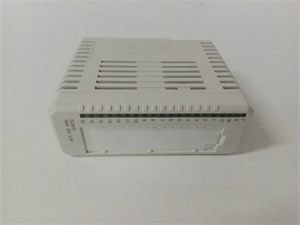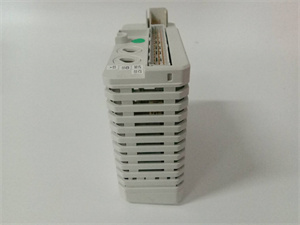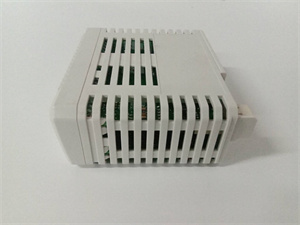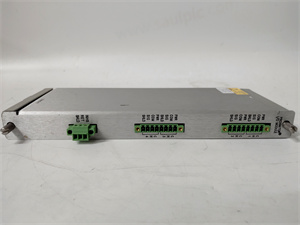Description
1. Product Description
The ABB DI810 is a high-performance digital input module designed for industrial automation systems, part of the ABB S800 I/O series compatible with the AC800M system. Engineered for reliable signal acquisition, the DI810 supports 16 channels of digital inputs, converting sensor and switch states into control system-compatible signals. Its dual isolated groups (2×8 channels) with voltage supervision enhance noise immunity and fault tolerance, making it ideal for harsh industrial environments. The module’s flexible filtering (2/4/8/16 ms) and compact design (45×102×119 mm) enable seamless integration into diverse automation setups. With certifications like EN 61010 and C1 Div 2/C1 Zone 2, the DI810 ensures compliance with global safety standards.
2. Product Parameters
| Parameter | Specification |
|---|---|
| Input Voltage | 18–30V DC (15–30V DC for “1” state; -30–+5V for “0” state) |
| Channels | 16 (2 isolated groups of 8 channels + 1 voltage supervision per group) |
| Input Type | Current sinking (6mA at 24V DC) |
| Isolation | Group-wise (2 groups), 500V AC dielectric test voltage |
| Filter Time | Programmable: 2, 4, 8, 16 ms |
| Communication | Modbus RTU (RS-485) via MTU (TU810/TU814/TU830 etc.) |
| Operating Temperature | -20°C to +60°C (standard); +5°C to +55°C (certified range) |
| Dimensions | 45 mm (W) × 102 mm (D) × 119 mm (H); 0.15 kg |
| Certifications | EN 61010, UL 61010, ATEX Zone 2, C1 Div 2, marine (ABS/BV/DNV/LR) |

ABB DI810
3. Advantages and Features
- Dual Isolation Design: Two independent isolated groups (8 channels each) with voltage supervision minimize cross-channel interference and ensure robust fault detection.
- Diagnostic Capabilities: LED indicators for channel status (0/1), fault (F), run (R), and warning (W), plus voltage loss alerts via the module bus.
- Wide Environmental Range: Operates in temperatures from -20°C to +60°C (standard) and withstands humidity (5–95% non-condensing) and pollution (Degree 2).
- Modular Flexibility: Compatible with ABB’s S800 I/O MTUs (e.g., TU810V1, TU814V1), enabling easy expansion and vertical/horizontal mounting.
- Safety Compliance: Meets EN 61000 (EMC), IEC 60664 (overvoltage), and RoHS/WEEE standards, ensuring long-term reliability.
4. Application Fields and Cases
- Industries: Manufacturing (e.g., automotive assembly), energy (power plants), water treatment, oil & gas, and infrastructure (building automation).
- Use Cases:
- Automotive Manufacturing: Monitoring conveyor belt sensors and robotic arm status in a production line, reducing downtime via real-time fault detection.
- Water Treatment: Tracking pump and valve states in a wastewater plant, optimizing process efficiency with 16-channel density and fast response times.
5. Competitor Comparison
Compared to similar digital input modules, the DI810 stands out with:
- Higher Channel Density: 16 channels in a compact form factor (45 mm width), reducing cabinet space vs. 8-channel alternatives.
- Enhanced Isolation: Dual-group isolation (vs. single-group designs) for superior noise resistance in high-interference environments.
- Flexible Filtering: Programmable input filters (2–16 ms) adapt to varying signal noise levels, unlike fixed-filter competitors.
ABB DI810
6. Selection Recommendations
- Compatibility: Ensure MTU compatibility (e.g., TU810/TU814) for Modbus RTU communication.
- Environment: For extreme temperatures (+55°C max certified), verify site conditions match the module’s rated range.
- Scalability: Choose the DI810 for high-density applications; opt for lower-channel modules (e.g., DI814) for simpler setups.
- Budget: Balance channel count and features (e.g., isolation, diagnostics) against project requirements.
7. Precautions
-
Wiring: Use shielded cables (max 600m) for current sinking inputs; follow ABB’s wiring diagrams for proper grounding.
-
Power Supply: Ensure stable 24V DC external power and 5V module bus power (50mA).
-
Installation: Vertical mounting recommended for optimal heat dissipation (max 55°C); avoid horizontal mounting in high-temperature environments.
-
Maintenance: Regularly inspect LED indicators for faults; replace modules under certified conditions to maintain safety certifications.






